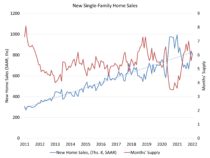New single-family home sales posted a small decline in January as housing demand was affected by a jump in mortgage rates. The January pace of sales was nonetheless solid due to a lack of resale inventory and ongoing need for new construction.
The U.S. Department of Housing and Urban Development and the U.S. Census Bureau estimated sales of newly built, single-family homes in January slipped to an 801,000 seasonally adjusted annual pace, a 4.5% decline from the revised December rate of 839,000. The January rate is 19.3% below the January 2021 estimate of 993,000, when demand was unsustainably strong due to historically low mortgage rates and a housing-focused covid economic rebound. As 2022 begins, sales appear to have settled back to the post-Great Recession long-run trend.

Median sales price in January increased to $425,300, a 13.4% year-over-year gain. Prices have increased as building material and other development costs have increased.
Sales-adjusted inventory levels are at a balanced 6.1 months’ supply in January. The count of completed, ready-to-occupy new homes is just 37,000 homes nationwide. Total inventory (for all stages of construction) increased to 406,000, a 34.4% gain from January 2021.
Inventories levels continue to rise due to several factors. First, construction times have increased, leading to more inventory in the pipeline. Second, inventory has increased with higher demand and lower resale supply. And finally, the components of inventory continue to adjust. As noted above, there are just 37,000 completed homes in inventory, 9.1% of the total. A year ago, completed homes represented 13.2% of inventory. In contrast, homes not started construction were 24.8% of inventory in January 2021 and increased to 26.1% in January 2022.

Regionally in January, new home sales declined in three regions; 10.7% in the Northeast, 7.4% in the South, 3.7% in the Midwest, but increased 1.2% in the West.
Discover more from Eye On Housing
Subscribe to get the latest posts sent to your email.


These are sales that closed escrow in January and many of these sales were likely made six to 9 months prior when interest rates were around 2.8% to 2.9% for a 30 year FRM. The Freddie Mac Mortgage Survey for last week (2/17) reported that rate to have increased to 3.92%, an increase of over 100 basis points.
Ordinarily, an increase of 1% in rate would not cause a panic but, since rates have been held artificially low since 2009, it represents an increase of over 35%. Rates have increased 70 basis points since January 6th alone and the FED will not be increasing short term rates until next month, likely 50 basis points.
This will undoubtedly slow sales but the problem builders should be focused on is protecting their backlog. Because of supply chain induced construction delays, most have much larger than normal backlogs and most sales were at record high prices.
The fact of the matter is that sales in the backlogs are at risk of being lost because the buyers can no longer qualify for the needed mortgage. If these potentially lost sales can be identified early on, many may be saved. I strongly recommend that builders conduct a thorough review of sales in their backlog to identify these potential losses and work with lenders to avoid as many lost sales as possible.
A clarifying note: existing home sales data are based on closed transactions, but the new home sales data reported in this post are based on signed contracts (they are the equivalent of pending homes sales but for new construction). These sales are based on contracts signed in January with rates applicable just a few weeks ago.